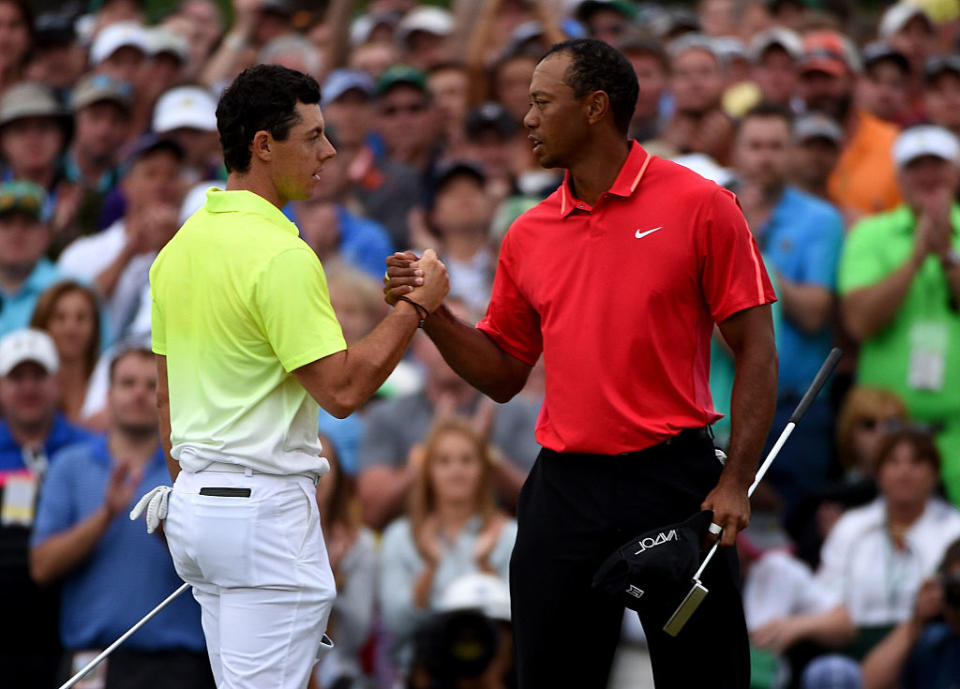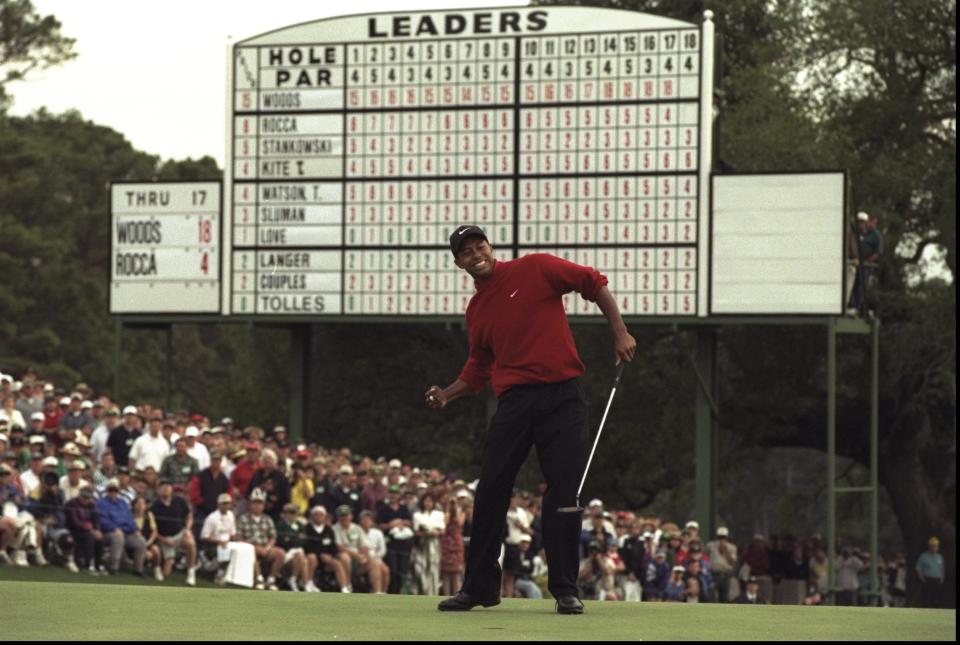Why there will never be another Tiger Woods

The Masters is roaring back into the national consciousness, a green-fairways-and-pink-azaleas wave that’ll fill your days with pimento cheese and piano music. And riding atop that wave: a red-and-black-clad king with a Scotty Cameron putter for a scepter.
Yes, Tiger Woods is returning to Augusta with his best chance to win in years, perhaps a decade. That in itself will drive most of the early Masters Week coverage. But before we descend yet again into Tigermania, it’s worth taking a step back and asking: why does Woods continue to command such attention? Why hasn’t anyone stepped up to match his marks? Where, oh where, is the next Tiger Woods?
Short answers, if you’re pressed for time:
1. Woods is, at worst, ranked 1A among the greatest golfers in history, and on the short list of most famous American athletes ever. If Michael Jordan came back to the court with a chance to school the Warriors, if Ali returned to the ring, if Babe Ruth dug in against Clayton Kershaw, you’d watch. Same deal here.
2. Asking why no one’s matched Woods is like asking why no one’s free-climbed the Washington Monument. How do you even start such an impossible task?
3. There’s no “next Tiger Woods,” and there never will be.
With all due respect to Rory McIlroy, Jordan Spieth, Dustin Johnson, Justin Thomas and the rest of the generational talents who now own the game: Woods is the 100-year floodplain of golfers. Time, distance and the need to be at the center of a historical movement have obscured the simple fact that Woods wasn’t just great, he was greater than we can even believe, from every possible angle.
Numbers don’t lie. Woods won two of his first seven tournaments as a pro. McIlroy, the first legitimate megastar in Woods’ wake, placed “only” as high as T10 in his first seven tournaments, while Spieth, the American heir apparent, managed a T2 in his third pro tournament. From the moment he first swung a club at the Greater Milwaukee Open in 1996, Woods was already at another level, one nobody else has stayed on for long. Part of the attraction of Woods was that he sprinted right past the entire rest of the PGA Tour like it was standing still, and nobody’s come close to that instant dominance ever since.
Even getting within sight of Woods, from a majors-won perspective, will be an astronomical task. Let’s consider the two likeliest current challengers, McIlroy and Spieth. Coming into the 2018 season, Woods had 328 career starts on the PGA Tour, with 79 wins and 14 majors. McIlroy has 131 Tour starts, with 13 wins and four majors, while Spieth has 127 starts, 11 wins, and three majors. If we project those numbers outward with a little back-of-the-scorecard math, by the time McIlroy gets to Woods’ total number of starts, he’ll have 33 wins and 10 majors, while Spieth will have 28 wins and eight majors.
Even if we give McIlroy and Spieth an extra 50 tournaments to account for the time Woods missed due to injury – assuming, of course, that neither of the younger two misses any more significant time on their own – McIlroy “only” gets to 12 majors, and Spieth to 10.
These numbers are skewed even further when you factor in the fact that Woods has gone 98 starts, coming into Augusta, without winning a major. His last came in 2008 at the U.S. Open in Torrey Pines, capping a run where he averaged more than a major a year. Nobody’s ever again getting close to that rate for anything approaching 14 years. Nobody.
Media coverage. Woods tore his way through the college ranks, winning the U.S. Amateur three times in a row. Not even Jack Nicklaus, whose feats a young Woods tracked on a poster in his bedroom, could claim that honor. And yet for all the acclaim Woods received, he still arrived on Tour something of a blank slate; pros wondered how he’d handle the mental rigor of a tournament (spoiler: just fine), while fans saw only his brilliant smile and steely stare (second spoiler: they wouldn’t get much more than that, ever). There’s no way a player would arrive so unexamined today; a Tiger-esque figure rising through the lower golf ranks would be dissected from every angle years before his (or her) first pro tournament.

Plus, Woods benefitted immensely from two landmark stories about him: Gary Smith’s “The Chosen One,” in Sports Illustrated, where Woods’ father Earl proclaimed Tiger the Messiah with a nine-iron, a man capable of bringing peace to mankind. (“Tiger will do more than any other man in history to change the course of humanity,” Earl said.) At the other end of the spectrum was Charlie Pierce’s “The Man. Amen.” for Esquire, which shredded the Woods-as-savior myth and showed Tiger for what he was – a 21-year-old with a normal kid’s love (and a sheltered kid’s lack of social awareness) for raunchy jokes.
Woods never came close to the promise of the first article, and completely shut his personal life off from the world after the second. But, again, the difference between then and now remains: not even a next-generation sports egotist like LaVar Ball thinks that his kids are going to save the world … and if any world-class athlete lets fly with the racial humor that Woods did back in 1997, it’ll represent a world-class failure of public relations to let those jokes get out.
The race factor. Earl Woods made explicit the fact that Woods’ success would represent a success for African-Americans, and Nike happily shot that bandwagon into orbit with its infamous “Hello World” commercial introducing Woods:
“There are still courses in the U.S. that I am not allowed to play because of the color of my skin,” ran words over the images of a young Woods, and even though Nike officials later conceded that wasn’t exactly, precisely true, the image of Woods as racial pioneer in a whitebread sport like golf was a compelling, provocative one.
With two decades’ distance, of course, we know that Woods didn’t end up opening the floodgates for a parade of African-American golfers; the Tour remains overwhelmingly white. And Woods himself – like his friend Michael Jordan – has continually dodged all attempts to paint him as some kind of racial spokesman. He’s grandfathered in at this point, but any future African-American phenom wouldn’t be able to get away with dodging the provocative and persistent questions of race in America.
What Woods has done is ushered in an attitudinal shift as well as an athletic one. Aside from the obvious exponential expansion of all things golf – ratings, sponsors, purses – Woods also inspired younger golfers to bring the tiniest hint of bat-flip arrogance to the course. McIlroy’s bulging biceps, Johnson’s decision to play golf rather than basketball, Spieth’s “go get that” exuberance on the course – all have their origins in Tiger, who carved right through golf’s soft, fleshy middle in the 1990s and changed the sport forever.
So no, there won’t be another Tiger Woods. No one’s touching his marks for decades, at the earliest. Which means you’ve got a rare chance to enjoy the genuine article again in the same place where his major dominance began. Woods tees off Thursday, and you’ll hear plenty about him before then … and rightly so.
Tiger at Augusta. As sports stories go, it’s a tough one to match … and an impossible one to top.
____
Jay Busbee is a writer for Yahoo Sports. Contact him at jay.busbee@yahoo.com or find him on Twitter or on Facebook.
More from Yahoo Sports:
• How Shaq’s impatience led to a $70K Walmart trip• Stanton makes 117 mph statement in Yankees debut
• Jackson’s curious decision sends message to NFL teams
• The Marlins waste no time in becoming MLB’s big joke

